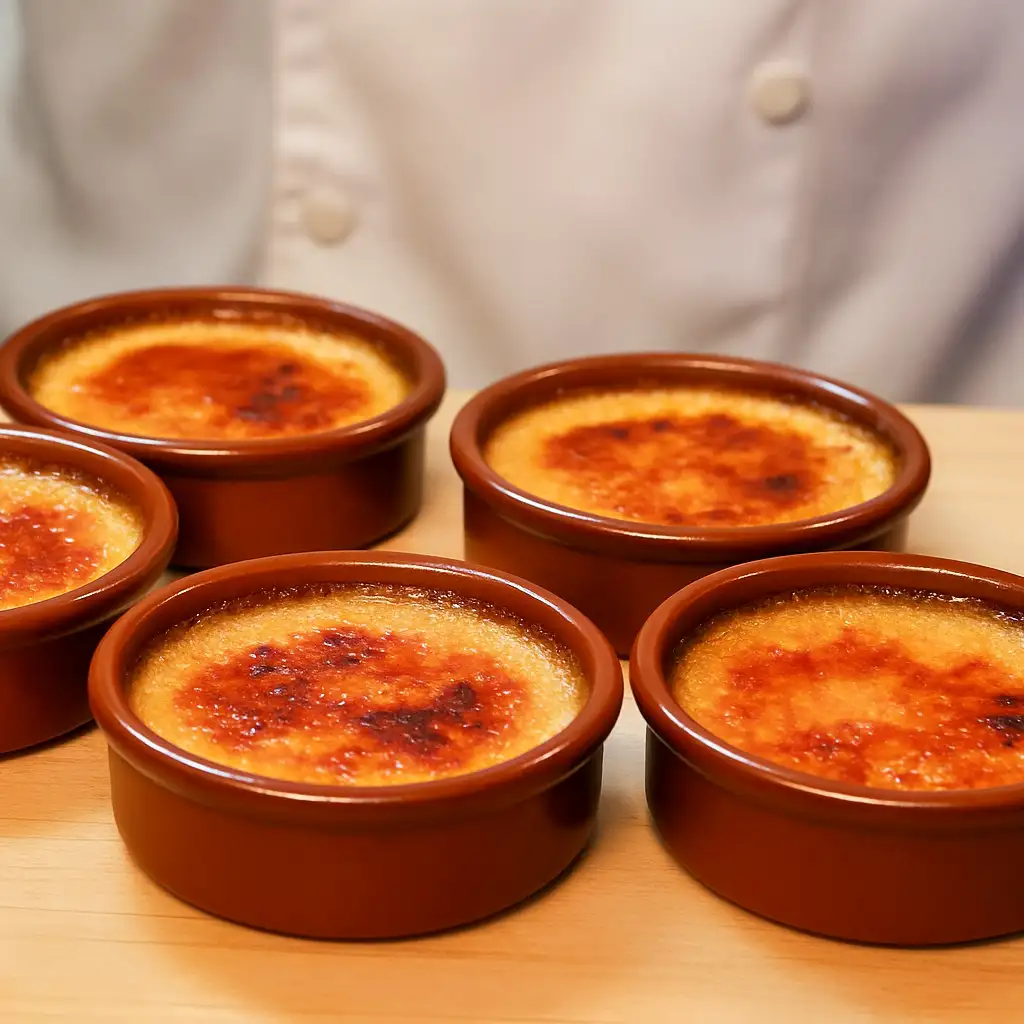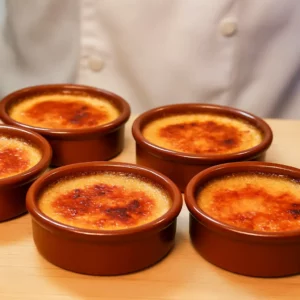Crème Brûlée Recipe with Caramelized Sugar Top – Easy French Dessert for Entertaining
There are few desserts as timeless as crème brûlée. That thin, glassy lid of caramel that shatters under the spoon; the cool, vanilla-scented custard beneath—this is the classic French dessert you can absolutely make at home in Canada or the USA with everyday grocery ingredients. The trick is low-and-slow baking in a bain-marie (water bath) and the right ratio of cream, egg yolks, and sugar.
This recipe is adapted from my YouTube video—there are a few small changes to improve texture (lower oven temperature and a slightly adjusted sugar ratio). Please watch the video as a visual guide for the steps and custard consistency.

Below you’ll find a step-by-step method (with chef tips) and a recipe card summary for easy printing or saving. If you enjoy French desserts, you might also like my takes on Chocolate Mousse, Raspberry Clafoutis, and Homemade Tiramisu—all simple, elegant, and perfect for dinner parties.
Why You’ll Love This Recipe
- Silky, restaurant-quality texture: Adjusted baking temperature (300°F / 150°C) prevents curdling and keeps the custard ultra-smooth.
- Balanced sweetness: A small bump in sugar keeps the flavor round without becoming overly sweet.
- Make-ahead friendly: Bake and chill hours (or a day) in advance; caramelize just before serving.
- Simple ingredients, big payoff: Cream, yolks, vanilla, sugar—classic French pantry staples.
Ingredient Notes
- Heavy cream (35%): Use 35% whipping cream for the classic richness and set.
- Egg yolks: Five yolks give a luxurious texture without becoming too eggy; you can use six if you prefer a firmer set.
- Vanilla: Use a vanilla bean (split and scraped) for the most aromatic custard, or a good pure vanilla extract.
- Sugar: We’ll sweeten the custard gently and reserve extra sugar for the brûlée crust.
If you’re serving crème brûlée after a rich meal, keep portions modest—4-oz (120 ml) ramekins are ideal. For more dessert inspiration, browse the Desserts section or my Pastries & Pies category.

Chef’s Adjustments (Compared to the Video)
- Lower bake temp: From 350°F/180°C down to 300°F/150°C for a satiny custard.
- Refined ratio: Slightly more sugar in the custard (still balanced), with plenty reserved for a thin, crisp caramel cap.
- Texture control: A fine-mesh strain before pouring ensures a perfectly smooth custard.
Use the video as a visual reference for whisking, pouring, and the jiggle test; use the written adjustments here to optimize texture and consistency.
Step-by-Step Instructions
1) Preheat & Prepare the Bain-Marie
- Preheat the oven to 300°F (150°C).
- Arrange 6 x 4-oz (120 ml) ramekins in a deep baking dish or roasting pan.
- Put a kettle or pot of water on to heat (for the water bath).
2) Mix Yolks & Sugar
- In a medium bowl, whisk 5 egg yolks with 120 g (½ cup + 1 tbsp) granulated sugar until the mixture looks slightly pale and thickened—about 30–45 seconds by hand. (Whisk gently; we don’t want excess foam.)

3) Heat the Cream with Vanilla
- In a saucepan, combine 500 ml (2 cups) 35% cream with 1 tbsp vanilla extract (or seeds from 1 vanilla bean plus the pod).
- Warm over medium-low heat just until steaming (do not boil). Remove from heat; if you used a vanilla pod, let it steep 5 minutes, then discard the pod.
4) Temper the Yolks
- Slowly drizzle the warm cream into the yolk mixture while whisking constantly. This prevents scrambling and creates a smooth custard base.

5) Strain & Portion
- Strain the custard through a fine-mesh sieve into a jug or bowl (this removes chalazae and any accidental bits).
- Divide evenly among the ramekins (fill almost to the top, leaving ~5 mm headspace).
- Skim any surface bubbles with a spoon or by touching lightly with the edge of a paper towel.

6) Bake Low & Slow
- Set the pan on the oven rack and carefully pour hot water into the pan until it reaches halfway up the ramekins.
- Bake 35–45 minutes at 300°F (150°C).
- Doneness: The edges should be set and the center should wobble like Jell-O when you jiggle the ramekin. If it’s liquidy, give it a few more minutes; avoid overbaking.

7) Cool & Chill
- Remove ramekins from the water bath; cool to room temperature.
- Cover and refrigerate at least 2 hours (up to 24 hours) to set fully and deepen the vanilla flavor.

8) Brûlée the Tops (Right Before Serving)
- Sprinkle the surface of each custard with a thin, even layer of sugar (about 1–2 tsp per ramekin).
- Caramelize with a kitchen torch in small circles until glassy and amber.
- No torch? Place under a very hot broiler for 1–3 minutes, watching constantly and rotating as needed. Chill 2–3 minutes to let the caramel harden.
Pro Tips for Success
- Sieve = silk: Don’t skip the fine-mesh strain—it’s the secret to a restaurant-smooth custard.
- Water level matters: Keep the water halfway up the sides; it buffers heat and prevents curdling.
- Bake by look, not by stopwatch: Pull when the center still wobbles; it will firm up as it cools.
- Sugar film, not sugar snow: A thin layer of sugar gives that glass-like snap without tasting burnt.
- Make-ahead: Bake and chill the day before; brûlée just before serving for the best crack.

Substitutions & Variations
- Yolks: Use 6 yolks for a firmer, richer crème brûlée; use 5 yolks (as written) for ultra-silky texture.
- Vanilla: Swap extract for a vanilla bean (1 whole bean, split and scraped) for a deeper aroma.
- Citrus twist: Infuse the cream with strips of orange or lemon zest, then strain.
- Espresso: Whisk 1 tsp instant espresso into the warm cream for a coffee crème brûlée.
- Dairy options: For the classic set, stick with 35% cream. Lighter creams will set softer and are easier to overcook.
Serving a full menu? Pair this with a bright coffee or a light dessert wine, and try my Fresh Strawberry Tiramisu or Chocolate Mousse for a French dessert trio.
FAQ
Can I make crème brûlée without a torch?
Yes—use your oven’s broiler (grill). Keep the ramekins close to the element and rotate for even caramelization. Watch closely; it can go from perfect to burnt in seconds.
Why did my custard curdle or look grainy?
Likely overbaking or too high an oven temperature. Bake at 300°F / 150°C and remove when the center wobbles. Always use a water bath and avoid boiling the cream.
How long does it keep?
The baked custards (un-brûléed) keep 2–3 days covered in the fridge. Add sugar and caramelize just before serving.
Can I use milk instead of cream?
Whole milk won’t set the same and the texture won’t be as luscious. For best results, use 35% cream.
My sugar won’t melt evenly—what am I doing wrong?
Use a fine, even layer of sugar and keep the torch moving in small circles. If broiling, make sure the sugar layer is thin and the broiler is fully preheated.
What to Serve with Crème Brûlée
Keep it simple: a few fresh berries, a tiny shortbread cookie, or a shot of espresso. For more French classics to pair in a dinner menu, have a look at French Onion Soup (FR), Carbonara (IT), or this elegant Beer-Battered Fish & Chips for a fun bistro twist.

Crème Brûlée Recipe with Caramelized Sugar Top – Easy French Dessert for Entertaining
Ingredients
Custard
- 500 ml 2 cups 35% cream
- 5 egg yolks use 6 for a firmer set
- 120 g ½ cup + 1 tbsp granulated sugar
- 1 tbsp vanilla extract or seeds from 1 vanilla bean pod removed after steeping
Topping
- 6 –12 tsp granulated sugar 1–2 tsp per ramekin
Instructions
- Preheat oven to 300°F (150°C). Arrange 6 ramekins in a deep baking dish; heat a kettle of water.
- Whisk yolks & sugar: In a bowl, whisk yolks and 120 g sugar until slightly pale (do not foam heavily).
- Warm cream & vanilla: Heat cream with vanilla until steaming; do not boil.
- Temper: Slowly whisk warm cream into yolks. Strain through a fine-mesh sieve.
- Portion: Divide into ramekins; skim bubbles.
- Bake bain-marie: Pour hot water into the pan halfway up the ramekins. Bake 35–45 min, until edges set and centers wobble.
- Chill: Remove from water, cool to room temp, cover, and refrigerate 2+ hours (up to 24 hours).
- Brûlée: Sprinkle 1–2 tsp sugar on each; torch until amber and glassy (or broil briefly). Rest 2–3 minutes to harden. Serve.
Video
Notes
FAQ
Can I make crème brûlée without a torch?Yes—use your oven’s broiler (grill). Keep the ramekins close to the element and rotate for even caramelization. Watch closely; it can go from perfect to burnt in seconds. Why did my custard curdle or look grainy?
Likely overbaking or too high an oven temperature. Bake at 300°F / 150°C and remove when the center wobbles. Always use a water bath and avoid boiling the cream. How long does it keep?
The baked custards (un-brûléed) keep 2–3 days covered in the fridge. Add sugar and caramelize just before serving. Can I use milk instead of cream?
Whole milk won’t set the same and the texture won’t be as luscious. For best results, use 35% cream. My sugar won’t melt evenly—what am I doing wrong?
Use a fine, even layer of sugar and keep the torch moving in small circles. If broiling, make sure the sugar layer is thin and the broiler is fully preheated.
Troubleshooting at a Glance
- Curdled edges? Oven too hot or baked too long → lower to 300°F/150°C; pull when still wobbly.
- Soft set? Chill longer; use 6 yolks next time for a firmer texture.
- Bitter top? Used too much sugar or heated too long—aim for a thin layer and light amber color.
More Desserts You’ll Love
Useful Links
🛒 Michel Dumas Shop : Explore our kitchen essentials, including aprons and knives.
🌐 Linktree : Access all our important links in one place.
📱 YouTube | Instagram | Facebook | TikTok : Follow us for the latest recipes and culinary tips.





